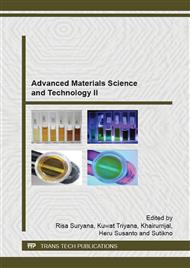p.155
p.160
p.164
p.169
p.173
p.177
p.182
p.187
p.192
Synthesis of Biodegradable Plastic Films from Oil Palm Empty Fruit Bunch Cellulose
Abstract:
Cellulose from Oil Palm Empty Fruit Bunch (OPEFB) has a possibility to be converted into biodegradable plastic cellulose ester due to its huge availability. Cellulose ester has thermoplastic properties and is widely used in many polymer applications. This paper describes about esterification OPEFB cellulose with long chain fatty acid chloride in homogeneous system. Some different molar ratios of anhydroglucose unit (AGU) to fatty acid chloride were applied to observe cellulose ester with regards to weight increase percentage (%WIP), recovery yield (%RY) and degree of substitution (DS). Others characteristics were also determined, such as solubility and tensile strength of film casting (MPa). Cellulose palmitate, cellulose laurate and cellulose oleate were successfully produced from OPEFB cellulose. The study found that there is a correlation between type and molar ratio of fatty acid chloride. In an identical reaction condition, a longer fatty acid chlorides and a higher ratio molar AGU to fatty acid chloride produce cellulose ester with high WPI except cellulose oleate ester.
Info:
Periodical:
Pages:
173-176
Citation:
Online since:
August 2015
Authors:
Price:
Сopyright:
© 2015 Trans Tech Publications Ltd. All Rights Reserved
Share:
Citation:


